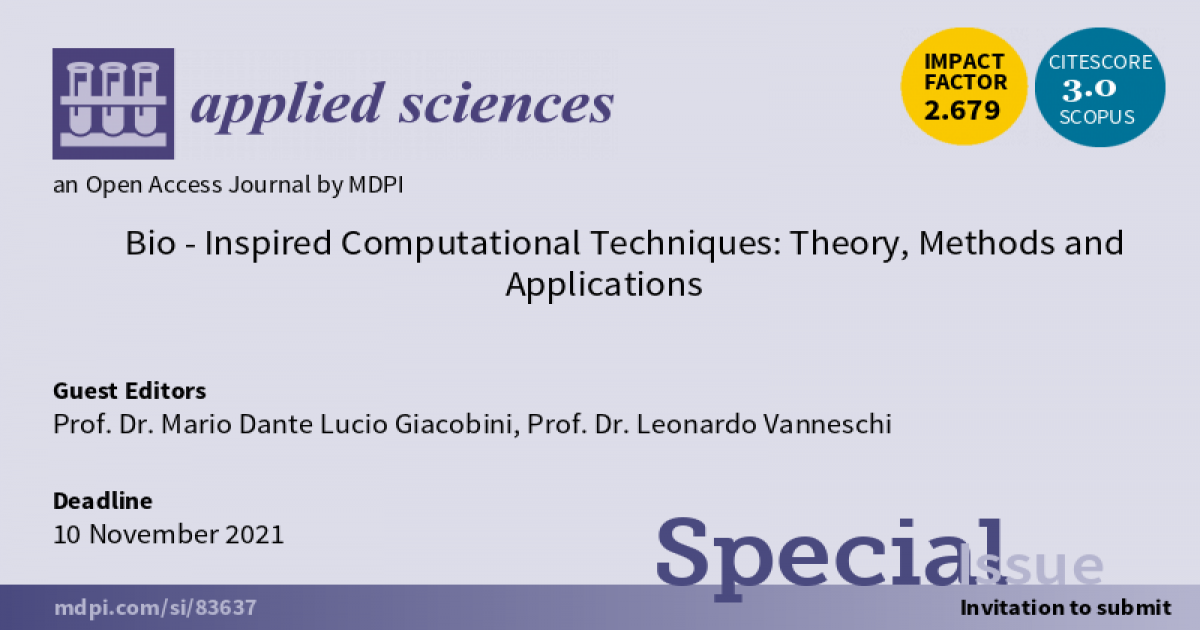Bio-Inspired Computational Techniques: Theory, Methods and Applications
A special issue of Applied Sciences (ISSN 2076-3417). This special issue belongs to the section "Computing and Artificial Intelligence".
Deadline for manuscript submissions: closed (10 November 2021) | Viewed by 8466

Special Issue Editors
Interests: computational epidemiology; evolutionary computation; computational biology; artificial life; complex systems
Interests: machine learning; genetic programming; particle swarm optimization
Special Issues, Collections and Topics in MDPI journals
Special Issue Information
Dear Colleagues,
Since the early days of Artificial Intelligence, nature has been seen as a great source of inspiration to provide solutions for complex problems. Under evolutionary pressure, aggregations of cells, tissues, organisms, and species are pushed to develop optimized skills for their survival, finding solutions that are often creative and unexpected. These emergent behaviors can be emulated to design computational techniques for tackling real-world problems. For over 70 years, bio-inspired algorithms represent a research area that takes inspiration from natural phenomena, in order to implement high-performance computing approaches and intelligent paradigms, with the aim of solving complex problems. Examples of bio-inspired computational techniques include, but are not limited to, artificial neural networks, evolutionary computation, swarm intelligence and ant colonies, just to mention a few. Bio-inspired computation not only results in a fruitful approach for solving real-world problems, but it also plays a fundamental role in artificial life, at the intersection between biology, mathematics, and computer science. Thanks to these approaches, models of natural phenomena can be built to interfere with their behavior.
The objective of this Special Issue is to collect original research articles as well as review articles that will draw the current framework of research in the area of bio-inspired algorithms and approaches to solve problems or to model phenomena in different domains.
Prof. Dr. Mario Dante Lucio Giacobini
Prof. Dr. Leonardo Vanneschi
Guest Editors
Manuscript Submission Information
Manuscripts should be submitted online at www.mdpi.com by registering and logging in to this website. Once you are registered, click here to go to the submission form. Manuscripts can be submitted until the deadline. All submissions that pass pre-check are peer-reviewed. Accepted papers will be published continuously in the journal (as soon as accepted) and will be listed together on the special issue website. Research articles, review articles as well as short communications are invited. For planned papers, a title and short abstract (about 100 words) can be sent to the Editorial Office for announcement on this website.
Submitted manuscripts should not have been published previously, nor be under consideration for publication elsewhere (except conference proceedings papers). All manuscripts are thoroughly refereed through a single-blind peer-review process. A guide for authors and other relevant information for submission of manuscripts is available on the Instructions for Authors page. Applied Sciences is an international peer-reviewed open access semimonthly journal published by MDPI.
Please visit the Instructions for Authors page before submitting a manuscript. The Article Processing Charge (APC) for publication in this open access journal is 2400 CHF (Swiss Francs). Submitted papers should be well formatted and use good English. Authors may use MDPI's English editing service prior to publication or during author revisions.
Keywords
- bio-inspired computing
- artificial neural networks
- evolutionary computation
- swarm intelligence
- algorithms
- theoretical foundations
- real-life applications
Benefits of Publishing in a Special Issue
- Ease of navigation: Grouping papers by topic helps scholars navigate broad scope journals more efficiently.
- Greater discoverability: Special Issues support the reach and impact of scientific research. Articles in Special Issues are more discoverable and cited more frequently.
- Expansion of research network: Special Issues facilitate connections among authors, fostering scientific collaborations.
- External promotion: Articles in Special Issues are often promoted through the journal's social media, increasing their visibility.
- e-Book format: Special Issues with more than 10 articles can be published as dedicated e-books, ensuring wide and rapid dissemination.
Further information on MDPI's Special Issue polices can be found here.






